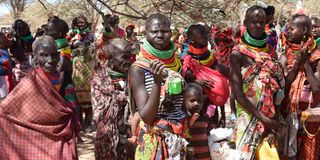Innovation for women must keep pace with needs of those in crises

Famine victims wait for relief food distribution at Nakaalei in Turkana County on November 5, 2022.
What you need to know:
- Harnessed effectively, technology can drive job creation, food production, climate change action, and energy access to make communities more sustainable.
- In an increasingly digital world, technology has become essential for everything we do, including learning, access to services, and improving livelihoods.
Technology and innovation have been proven to be game-changers in driving progress towards the Sustainable Development Goals.
Harnessed effectively, technology can drive job creation, food production, climate change action, and energy access to make communities more sustainable.
In an increasingly digital world, technology has become essential for everything we do, including learning, access to services, and improving livelihoods.
Because technology permeates every aspect of modern life, the digital divide has become a more urgent issue than ever before. In crises and humanitarian settings, the digital divide can limit women’s access to life-saving information and services, effectively heightening their risks to maternal deaths, gender-based violence, and harmful practices such as female genital mutilation and child marriage.
The Covid-19 pandemic is a health, humanitarian and development crisis that aptly highlighted the multifaceted challenges faced by women and girls in emergencies. It resulted in the shadow pandemic of gender-based violence, with cases going up by more than 87 per cent across the country in 2020, as reported by the National Crime and Research Centre.
A gender assessment of the impact of Covid-19 in Kenya showed that the pandemic led to loss of jobs and other sources of income for more women, with 20 per cent of women losing their livelihoods as compared to 12 per cent of men.
Well-designed technology can be leveraged to address gender inequalities for a more effective response to humanitarian crises. Consider the Wheels for Life Initiative launched in April 2020 in response to the Covid-19 pandemic.
This tele-health innovation by the Ministry of Health in collaboration with public and private sector partners enabled women facing pregnancy-related medical emergencies to access essential services during curfew hours by linking them to healthcare providers and emergency transport through a toll-free line.
As Kenya faces the worst drought experienced in the last four decades, technologies, such as portable ultrasound devices, cash transfers through mobile phones or mapping tools to identify vulnerable and at-risk women and girls, can help facilitate more timely dispersal of life-saving assistance to those in need.
These technologies have been deployed successfully in emergencies by the Kenya Red Cross and UNFPA to support access and utilisation of health services in remote, arid and semi-arid counties where healthcare services are deprioritised.
In counties most affected by the drought, UNFPA and the Kenya Red Cross are working jointly to improve access to mental and psychosocial support and referral services for women and girls through national toll-free helplines 1199 operated by the Kenya Red Cross, and 1195, managed by Healthcare Assistance Kenya.
These helplines also provide data that helps inform gender-based violence and sexual and reproductive health interventions in emergencies.
Women and girls must be included as co-creators in the design and development of new technology, to ensure that digital products equally reflect their realities. The more women and girls are included in the creation of technology, the less vulnerable they will be.
Now more than ever, we need to harness social innovation to challenge systemic social and cultural norms that drive gender inequality, while empowering women and girls to live in dignity, no matter their circumstance.
Using a user-centered approach that is focused on understanding the needs of the most marginalised women and girls is central to the achievement of the sustainable development goals and our promise to leave no one behind. This must remain our shared vision and commitment to ensuring a better future for all Kenyans.
A joint opinion piece by UNFPA Representative Anders Thomsen and Kenya Red Cross Secretary General Dr Asha Mohammed.




